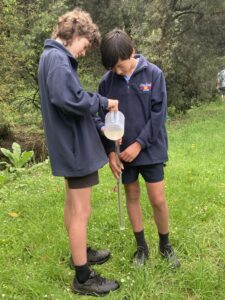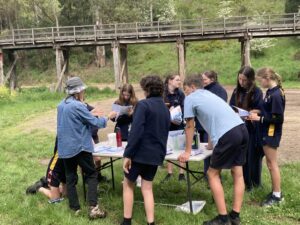It’s great to share what River Detectives schools are up to. This report came in from Andrea at Timboon P-12 School’s Timboon Agriculture Project (TAP). We love this idea of following a waterway throughout the catchment and testing along the way.
Educators should be able to post their own updates on Billabong Banter but the tech is not cooperating so please, if you have a paragraph or photos to share, feel free to send them to riverdetectives@nccma.vic.gov.au and I’ll post them on your behalf. Nicole.
How lucky are our Year 7 ‘Water in the World’ Humanities students who have access to these amazing environs as an extension of their classroom by following the Curdies River, ‘From Source to Sea’.
Our field trip began at Lake Elingamite, not really the source of the Curdies, but a closer volcanic maar lake, where we tested water sourced from Lake Purrumbete, in the actual catchment area. Our guides for the water testing were environmental educator, Debbie Dalziel (Curdies Valley Landcare Network), who tested electrical conductivity, Kate Leslie (HDLN) who recorded the pH and habitat data, Michelle Leech (HDLN) captured the reactive phosphorus and Monique, a student teacher, helped record the turbidity and temperature.
Our budding environmentalists then travelled through the Curdies Valley where tributaries flow through the hills of the Heytesbury farming district to the Trestle Bridge at Timboon. Data was collated at our River Detectives monitoring site on the Curdies adjacent to the Crater to Coast Rail Trail before students followed the river as it meanders through Curdievale past the Boggy Creek Pub. Water was gathered and tested at the Boggy boat ramp before students travelled to the Curdies estuary at Peterborough.
Water collected from our four testing sites was inspected for water bugs as indicators of the health of the waterways with varying species present in each sample. Our final water tests included water collected from the Peterborough boat ramp and, supplemented by information garnered by the students’ data, scavenger hunt, human impact records, photo hunt and ‘wonder and notice notes’ students will collate this information to better understand the health of this vital waterway.







